Eucalyptus Plant Benefits
The Eucalyptus plant (Eucalyptus spp.) is a versatile and fragrant addition to any space, valued for its silvery-green leaves, therapeutic properties, and decorative appeal. Native to Australia, this plant has gained global popularity for its aesthetic charm. Whether grown indoors in a pot or as a garden tree, the Eucalyptus offers multiple benefits.
Benefits of the Eucalyptus Plant

1. Natural Air Freshener
The Eucalyptus plant emits a refreshing, clean aroma that instantly uplifts the space. Its scent is linked to relaxation and improved focus, making it a natural choice for bedrooms, offices, and meditation areas.
2. Air Purification
Eucalyptus improves air quality by absorbing carbon dioxide and releasing oxygen. Its subtle scent helps eliminate odors and creates a fresher indoor environment.
Tip:
Place it in high-traffic areas to maximize its purifying benefits.
4. Aesthetic Value
The elegant, silvery foliage of the Eucalyptus plant adds a sophisticated touch to any decor. It’s often used in floral arrangements, wreaths, or as dried decor for a timeless look.
Design Idea:
Hang fresh or dried Eucalyptus leaves in the bathroom to create a spa-like ambiance.
5. Stress Relief
The refreshing aroma of Eucalyptus promotes relaxation, reduces stress, and enhances focus. Its presence can promote a serene and focused atmosphere.
How to Care for Your Eucalyptus Plant
1. Light Requirements
Eucalyptus thrives in bright, direct sunlight. For indoor plants, place them near a south-facing window or under grow lights.
Tip:
Turn the plant weekly to provide balanced light exposure for uniform growth.
2. Watering
This hardy, drought-resistant plant thrives in well-draining soil and requires minimal, infrequent watering. Overwatering can cause root rot.
Watering Tip:
Let the top inch of soil dry out entirely before watering to prevent overwatering.
3. Soil and Fertilization
Eucalyptus plants grow best in well-draining, sandy soil with a neutral to slightly acidic pH. Apply fertilizer sparingly during the growing season to support healthy growth.
Soil Tip:
Mix potting soil with sand or perlite to improve drainage.
4. Pruning and Maintenance
Regular pruning helps maintain a compact shape and encourages bushier growth. Remove dead or damaged leaves to ensure the plant stays healthy.
Care Tip:
Prune in late winter or early spring, just before new growth begins, to encourage a healthy and vibrant plant.
5. Temperature and Humidity
Eucalyptus thrives in warm temperatures ranging from 65°F to 75°F (18°C to 24°C) and prefers low humidity levels.
Placement Tip:
Avoid exposing the plant to cold drafts or placing it near air conditioners.
Common Issues and Solutions
- Yellow Leaves: Overwatering is the likely cause. Allow the soil to dry out completely between waterings.
- Pest Problems: While Eucalyptus is generally pest-resistant, it may occasionally attract spider mites. Use neem oil or insecticidal soap to treat infestations.
- Leggy Growth: Insufficient light can result in sparse stems. Relocate the plant to a sunnier spot.
Conclusion
The Eucalyptus plant is a harmonious blend of aesthetic charm, therapeutic benefits, and ease of care. Whether adorning your living room or enhancing your garden, this versatile plant offers an array of advantages for both body and mind. With proper care, the Eucalyptus will continue to thrive, providing beauty, fragrance, and wellness benefits for years to come.

